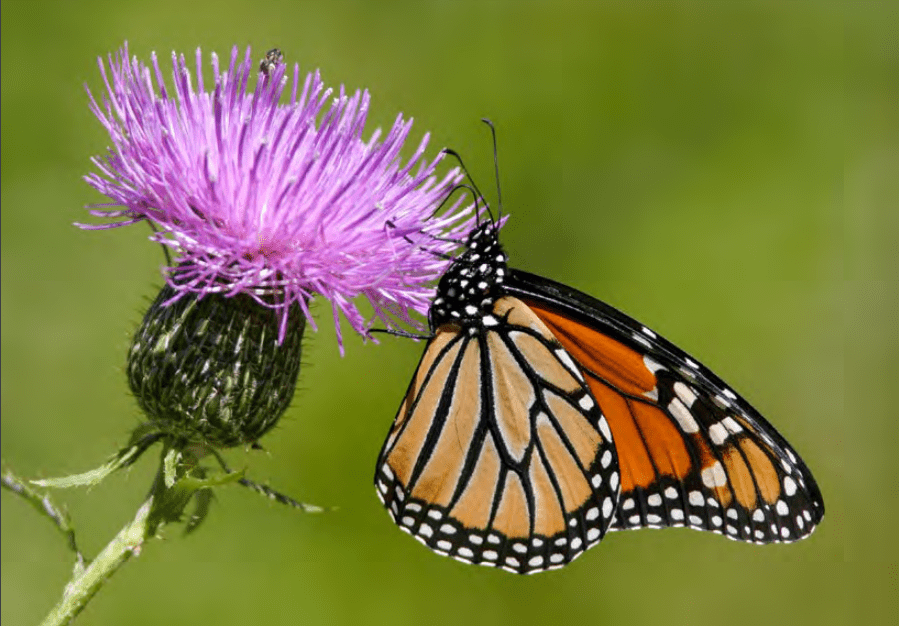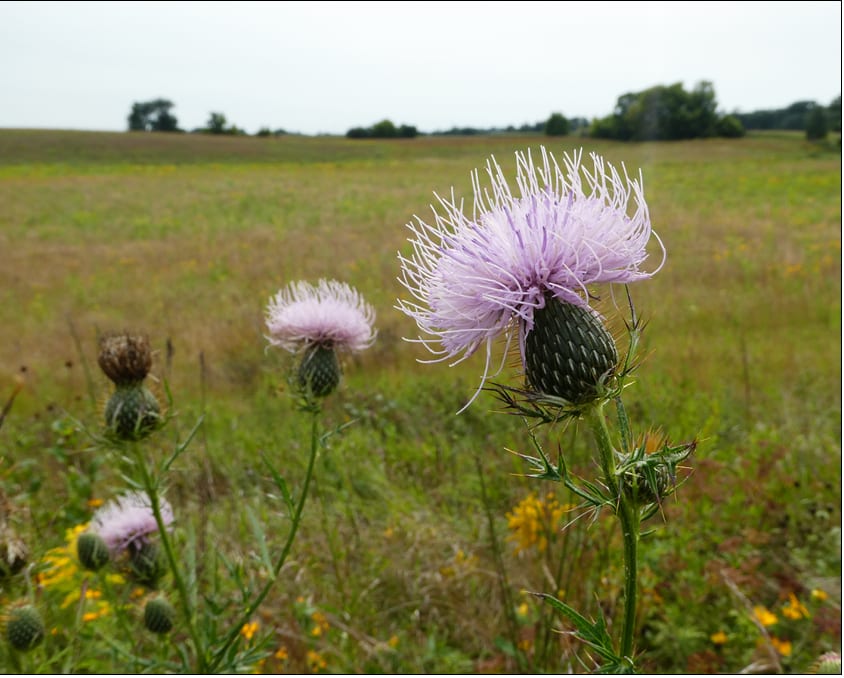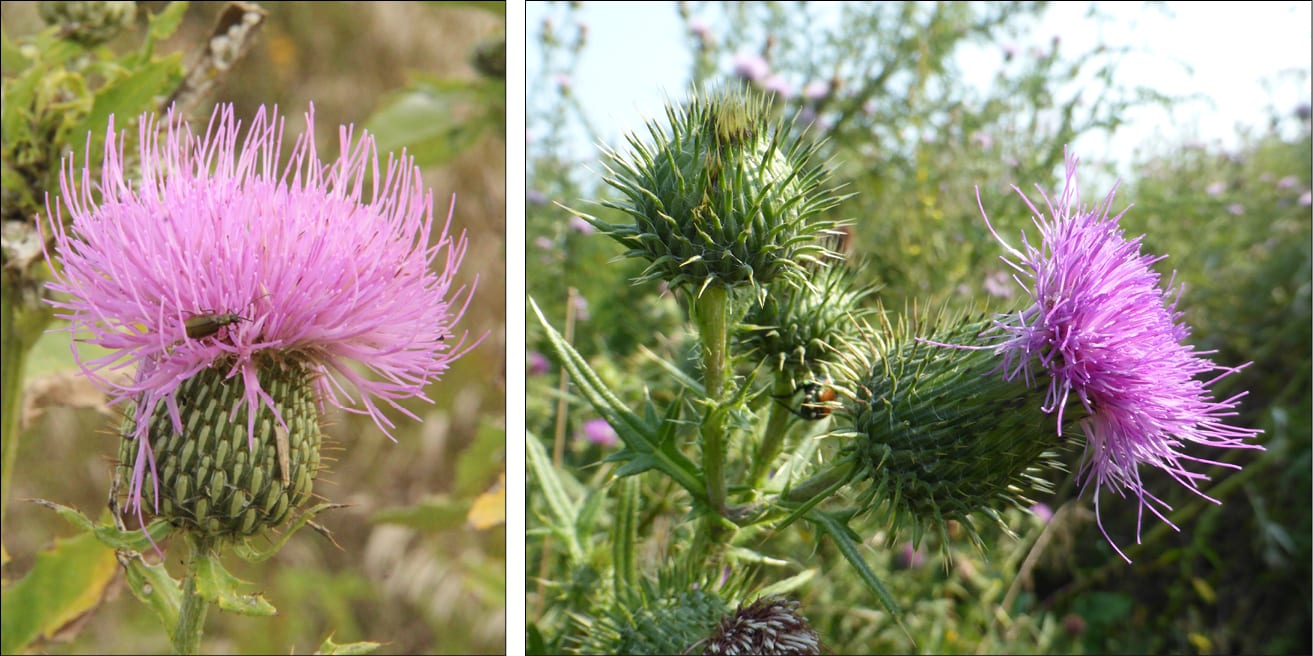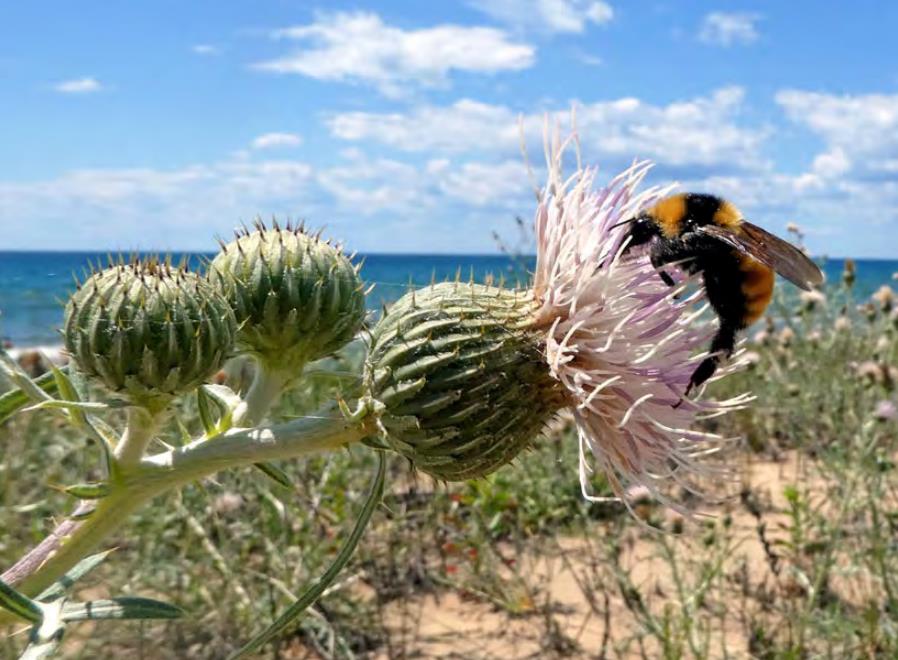by the Xerces Society
Native thistles are a largely misunderstood and wrongly maligned group of wildflowers. Often confused with their prickly, invasive relatives such as Canada thistle, in reality, native thistles are benign and valuable plants that fill a variety of significant niches alongside more esteemed wildflowers such as coneflowers, prairie clovers, and blazing star.
While so many of those native wildflowers have been embraced by restoration practitioners, gardeners, and native plant enthusiasts, native thistles haven’t garnered the same enthusiasm, and that’s too bad. With sublime blue-green foliage, interesting stem and leaf architecture, and flamboyant pink blossoms, our native thistles are every bit as resplendent—and as valuable for wildlife—as countless other native plants. It is time to change attitudes towards our native thistles and recognize their importance, and the first step is to provide conservation practitioners with the information they need to plant, protect, and grow these important native plants.

Native thistles are a valuable resource for monarchs. The Xerces Society includes regionally native species in its Monarch Nectar Plant Guides Photo: Judd Patterson
Native thistles (genus Cirsium) fill important niches in our ecosystems. In great grasslands and prairies, alpine meadows, and silty Midwestern river bottoms, the seeds of our native thistles help sustain enormous flocks of songbirds such as goldfinches and indigo buntings. The nectar of these plants fills the stomachs of countless flower visitors, including the enormous black and gold bumble bee (Bombus auricomus), while the foliage of thistles feeds both people and rare butterflies alike. Edible thistle (Cirsium edule) is a staple food of the Salish people of the Pacific Northwest, while swamp thistle (C. muticum) is a caterpillar host plant for the swamp metalmark butterfly (Calephelis muticum), listed as endangered in Wisconsin.

Thistles occur in an extraordinary range of habitats. Here field thistle (C. discolor) dots a grassland in the upper Midwest. Photo: The Xerces Society/Sarah Foltz Jordan
Native Thistles Are Disappearing
As with so many of our other native prairie and meadow species, thistles have been a direct casualty of habitat loss due to agriculture, urbanization, and the development of cities and roads. Most significantly, they have suffered from the invasion of non-native thistles as indiscriminate weed control efforts often eradicate native thistles along with their problematic relatives. Many of our policies and activities are heralding the potential end of these beautiful plants. A number of native thistle species are now threatened with extinction.

Conservation of certain native thistle species like tall thistle (C. altissimum), left, may help contribute to controlling non-native species such as bull thistle (C. vulgare), right. Tall thistle supports a reservoir of native insect herbivores that spill over onto bull thistle and cause severe feeding damage, which can limit invasion by the non-native thistle. Photos: The Xerces Society/Jennifer Hopwell (C. altissimum) and The Xerces Society/Sarah Foltz Jordan (C.vulgare)
In fact, in response to the spread of exotic invasives such as Canada thistle (an import from Eurasia, not Canada), expansive biocontrol programs have released alien thistle-eating insects that devour nonnative and native thistles alike. These biological control efforts have only had limited impacts on some invasive thistles, but likely devastating impacts on our native ones. This pressure has been compounded by farm-level thistle eradication efforts, including the ever-increasing use of herbicides. And finally, some broad-reaching weed control policies treat all members of the genus Cirsium as noxious weeds, ignoring the potential to push historically common native thistles toward local extinction.

Pitcher’s thistle (C. pitcheri) is a federally threatened species found along sand dune on the shores of the upper Great Lakes. Photo: The Xerces Society/Sarah Foltz Jordan
Bringing Thistles Back
Native thistles deserve to be returned to their rightful place in the landscape. Xerces’ new publication Native Thistles: A Conservation Practitioner’s Guide provides the information necessary to do this. The guide includes a comprehensive discussion of thistle taxonomy, highlights the value of native thistles for pollinators and other wildlife, and provides a detailed account of the conservation status of native thistles. Given the significance of the invasion of non-native thistles and the ramifications of the non-native species on their native counterparts, Xerces provides a brief history of the arrival, spread, and efforts to control one of the most invasive thistles in North America, Canada thistle. Finally, the guide provides a section on the production of native thistle seed for use in restoration projects. This section on propagation and seed production is based on multiple years of actual native thistle seed production by the Xerces Society Pollinator Conservation Program in partnership with a group of fantastic native seed companies.
Native Thistles is a valuable resource for public land managers, native seed producers, and landowners as they take steps to conserve and protect a beautiful and important group of native plants.
About the Xerces Society
The Xerces Society is a nonprofit organization that protects wildlife through the conservation of invertebrates and their habitat. Established in 1971, the Society is a trusted source for science-based information and advice. Our conservation team draws together experts from the fields of habitat restoration, entomology, botany, farming, and conservation biology with a single focus: protecting the life that sustains us. To learn more about our work, please visit www.xerces.org.
***
Each author appearing herein retains original copyright. Right to reproduce or disseminate all material herein, including to Columbia University Library’s CAUSEWAY Project, is otherwise reserved by ELA. Please contact ELA for permission to reprint.
Mention of products is not intended to constitute endorsement. Opinions expressed in this newsletter article do not necessarily represent those of ELA’s directors, staff, or members.

